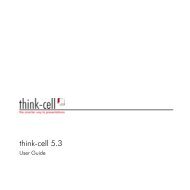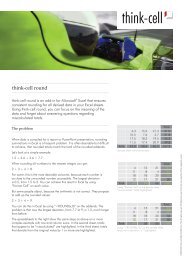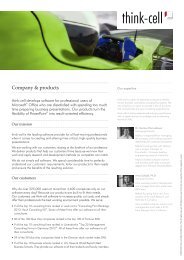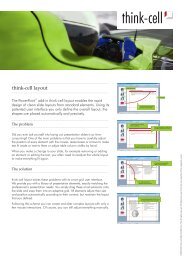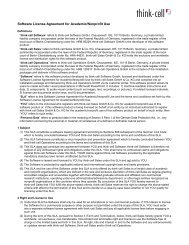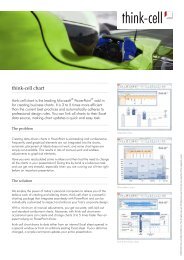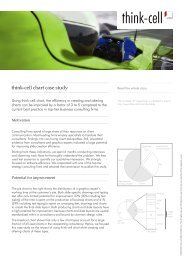think-cell technical report TC2003/01 A GUI-based Interaction ...
think-cell technical report TC2003/01 A GUI-based Interaction ...
think-cell technical report TC2003/01 A GUI-based Interaction ...
You also want an ePaper? Increase the reach of your titles
YUMPU automatically turns print PDFs into web optimized ePapers that Google loves.
2.1 Qualitative Aspects FIELD STUDY<br />
take slides from different PowerPoint files and adapt them for a new presentation,<br />
using correction tape and handwritten remarks.<br />
A Consultant’s Tools. Apart from communication devices – telephone, <strong>cell</strong>-<br />
phone, telefax, email, organizer – there’s only a handful of tools which are essential<br />
to the consultant’s work: Microsoft Excel, Microsoft PowerPoint, a calculator, a<br />
pen, a personal note pad, a yellow pad and correction tape.<br />
The entire project related communication with team members as well as with<br />
customers is <strong>based</strong> on PowerPoint slides and Excel sheets. Both kinds of data evolve<br />
continuously throughout the course of a project. Presentations of intermediate<br />
results are usually <strong>based</strong> on the same, iteratively refined PowerPoint file. The final<br />
version of the file at the same time serves as a documentation that is handed over<br />
to the customer when the project ends.<br />
In Microsoft Excel, consultants mostly use features for numeric aggregation<br />
(sum, average, etc.). They also make heavy use of live links between sheets and<br />
even between Excel files, but apparently they never create live links between Excel<br />
sheets and PowerPoint presentations. Excel sheets are sometimes used to hold large<br />
amounts of text, which requires all kinds of tedious work like manual line wrapping,<br />
formatting and merging of <strong>cell</strong>s, because Excel is not prepared for managing entire<br />
paragraphs of text. On the other hand, the elaborate Excel features to create charts<br />
are almost never used, because charts are only required for presentations and it is<br />
left to the visuals to create those charts in PowerPoint.<br />
Basic Slide Layout. There is a common standard to which most slides produced<br />
in a consultancy adhere. Some of these elements are also marked on the yellow pad<br />
blanks. The most common elements, their use, formatting, and meaning is indicated<br />
in figure 3.<br />
It is striking that consultants typically put loads of information onto a single<br />
slide. Students in academia are told to use font sizes no smaller than 18 points.<br />
Consultants use font sizes no bigger than 18 points and on dense slides go down to<br />
even 10 points. However, consultancies as well as academics agree on the general<br />
rule that there should be no more than three different font sizes on a single slide.<br />
Consultants make extensive use of graphical elements like boxes, lines, bubbles<br />
and a variety of different arrows and pointers. They also like to visualize recurring<br />
concepts by a thumbnail of the figure which first explained the concept. Depend-<br />
ing on the context and purpose, consultants use detailed charts <strong>based</strong> on actual<br />
numbers, or symbolic charts that convey a certain tendency or idea.<br />
Best Practices. The PowerPoint experts in the visual pool developed a range of<br />
best practices, which are used to solve a certain problem in a certain way. Typically,<br />
so-called best practices provide an indication of missing or unusable features in the<br />
software being used. Some of the best practices are well-known and shared by<br />
everybody involved, others are more of a personal habit. For this reason, visuals<br />
15



